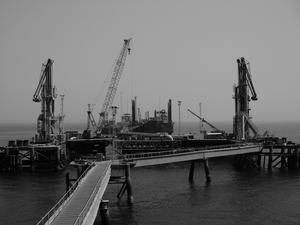| Revision as of 21:44, 24 December 2009 editKamran the Great (talk | contribs)Extended confirmed users3,472 editsNo edit summary← Previous edit | Revision as of 13:38, 29 December 2009 edit undoBeagel (talk | contribs)Autopatrolled, Extended confirmed users, Pending changes reviewers, Rollbackers90,411 editsm not a stubNext edit → | ||
| Line 14: | Line 14: | ||
| ] | ] | ||
| ] | ] | ||
| {{petroleum-stub}} | |||
Revision as of 13:38, 29 December 2009



Al Basrah Oil Terminal is an Iraqi oil port. It lies southeast of the Al Faw peninsula in the Persian Gulf. Al Basrah Oil Terminal is more commonly referred to as "ABOT" and it, along with its sister terminal, the Khawr Al Amaya Oil Terminal or 'KAAOT", provides platforms from which a large majority of Iraq's oil can be exported. ABOT and KAAOT are major players in Iraq's eventual economic stability and therefore is widely considered one of the top terrorist targets in the world due to its importance. The terminals maintain strict security and are guarded by both the Iraqi Navy and Marines and U.S. Forces including personnel from the U.S. Navy's Maritime Expeditionary Security Force, which falls under the Naval Expeditionary Combat Command. MESD 823 currently serves on board the Al Basrah terminal and provides security and security training to Iraqi Sailors and Marines.
The dilapidated and fragile nature of the terminal was featured in an NPR story on June 20, 2009.
References
Categories: